 |
|
|
|
|
||||||||||||||||||||||||
| [Research Interests] [Research Projects] [Selected Publications] |
Member of ACM.
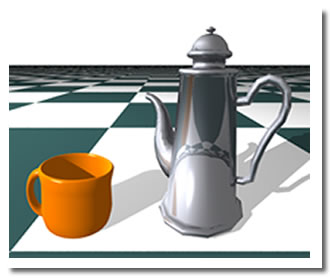
My research interests include applying Partial Differential Equations (PDEs) for Data-driven Implicit Shape Modeling and Medical Image Processing, Information Visualization, and Non-photorealistic Rendering.
Information Visualization Tools for Medical Literature
Efficient indexing in an information domain can greatly help the collection, organization, classification, analysis and retrieval of relevant information. However, the assessment of indexing techniques is a challenging topic because there are no universal references to serve as ground truth for a given literature. From the information visualization point of view, indexing results from different indexing techniques can form different graphical patterns in a visual information space for easy exploration and comparison. To demonstrate this, we present a visualization framework that graphically displays indexing results from different indexers (namely human indexers and MTI, an automatic indexing system) over the Medical Subject Headings (MeSH) vocabulary to allow users intuitively evaluate their performance.
Data-Driven Implicit Surface Reconstruction and Modeling
One of my research topics is using PDEs to reconstruct implicit models from scattered data points with higher-order derivative information such as normal and curvature, which can provide higher-order continuity of reconstructed scalar field distribution. The PDE-based data-driven implicit modeling framework adapts the mathematics of Taylor polynomials to define implicit interpolation functions with higher-order differential information. It also uses normal and curvature information for constraints optimization of given datasets.
Medical Image Filtering and Registration
After joining OHPCC, I started using Insight Toolkits (ITK) for medical image processing. In particular, I�m applying PDE techniques with ITK for image filtering, segmentation and registration. I integrate statistics information and differential properties of images to develop image filters using statistical functions along gradient and tangent directions for image smoothing, noise removal, etc. I�m also working on image-to-image registration of intravascular ultrasound image sequences based on mutual information and diffusion registration algorithms.
Non-Photorealistic Rendering (NPR)
We are working on the project of PLAWARe (Programmable Layered Architecture with Artistic Rendering), an open-source multi-platform software architecture capable of supporting a wide range of non-photorealistic rendering (NPR) techniques. This framework allows exploration of different algorithmic approaches to achieve a broad range of artistic styles in rendered images. It allows flexible management and study of multiple NPR algorithms, enabling rapid development of new techniques and element placement strategies.
My dissertation research dedicates to maximize modeling potentials of PDE techniques for graphical models. I have proposed a general PDE-based modeling paradigm that employs elliptic and parabolic PDEs with numerical techniques for geometric and physics-based shape modeling and manipulation. I presented an integrated framework that can model graphical objects of commonly used geometric representations, such as parametric models, polygonal meshes, and implicit functions. The prototype modeling and design system I developed can provide users powerful and intuitive sculpting toolkits for geometric objects. It offers modeling features of both explicit and implicit representations. The applications include object design from arbitrary curve sketches, model reconstruction from unorganized scattered data points, interactive shape sculpting for geometric surfaces and displacement models with physical properties, direct and free-form solid manipulation and deformation, implicit objects modeling with intuitive local operations, as well as medial axis extraction of arbitrary topological meshes and skeleton-based shape manipulation and recovery by diffusion-based front propagation techniques. The system allows users to design and manipulate geometric objects intuitively without worrying about the underlying mathematical and physical details.
PDE-Based
Free-Form Deformation
The solid elliptic PDE offers free-form deformation of solid objects because it governs the entire 3D parametric domain and provides a natural mapping between parametric and physical space. PDEs can also model implicit shapes defined on scalar intensity fields. To take advantages PDE techniques for both parametric models and implicit objects, we present an approach integrating parametric and implicit PDEs to define the solid geometry with physical properties and intensity distributions of objects subject to flexible boundary conditions. The integrated formulation of second-order or fourth-order elliptic PDEs and the associated dynamic principle permit designers to model and deform PDE solids with various degrees of freedom. Users can easily model and interact with solids of complex geometry and/or arbitrary topology from locally-defined PDE primitives through direct manipulation and free-form modeling and deformation. We employ the finite-difference discretization and the multi-grid subdivision to solve the PDEs numerically. Our PDE solid modeling system offers users various sculpting toolkits for solid design and manipulation, which allow them to interactively modify physical and geometric properties of arbitrary points, curve spans, regions on boundary surfaces and any interior parts of solid objects. Furthermore, the integration of implicit intensity information with solid geometry offers more general and arbitrary shape blending and free-form modeling and deformation for PDE solids with intensity attributes than pure geometric models. The physics-based PDE solid formulation and its associated dynamic principle permit designers to directly deform PDE solids whose behaviors are natural and intuitive subject to imposed constraints. Users can easily model and interact with solids of complicated geometry and/or arbitrary topology from locally defined PDE primitives.
 |
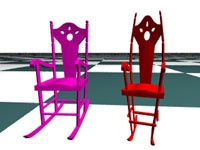 |
 |
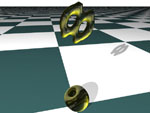 |
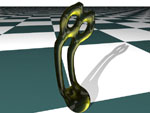 |
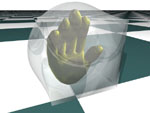 |
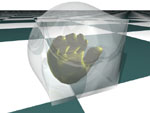 |
Medial
Axis and Skeleton Extraction and Shape Manipulation Using PDEs
We proposed a novel technique that uses diffusion equations to approximate
medial axes of arbitrary 3D objects represented by polygonal meshes. The
medial axis extraction process can be visually displayed by solving the
time dependent diffusion equations. Furthermore, diffusion-based front
propagation models governed by diffusion equations were used to recover
the original data from the medial axis/skeleton and design general sweeping
objects. This will greatly improve the time performance of shape manipulation
and animation of complex objects by deforming the skeletons first and
reconstruct the corresponding objects accordingly.
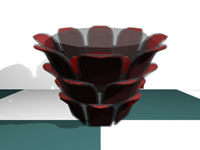 |
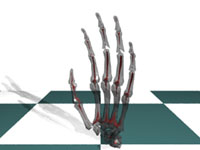 |
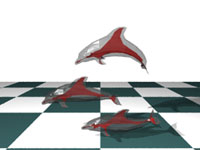 |
Implicit
PDE Shape Modeling
Implicit functions offer modeling advantages such as arbitrary topology,
collision detection, free of parametric correspondence, etc. Our implicit
PDE formulation provides properties of both PDE methods and implicit functions.
The implicit PDE model has the capability to reconstruct a complete model
from partial information such as sketch curves, scattered points and damaged
datasets. It facilitates the direct manipulation of underlying volumetric
datasets via sketch curves, iso-surface sculpting, deformation of arbitrary
interior regions, as well as a set of CSG operations inside the working
space. It allows designers to interactively sketch the curve outlines
of the object and directly manipulate implicit PDE objects. Its applications
include sketch-based shape design, model reconstruction, damaged data
recovery, as well as shape blending.
 |
 |
 |
 |
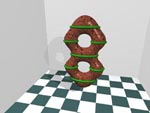 |
 |
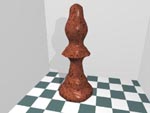 |
 |
Physics-Based
PDE Surfaces
PDE techniques can recover entire geometric surfaces with high continuity
by given boundary information, which alleviates the burden for tedious
specification over entire surface domain. The PDE surface modeling is
able to model parametric surface, polygonal meshes, and surface displacements
using an elliptic PDE formulation with integrated physical properties.
It allows interactive design of surfaces of flexible topology as PDE surfaces
or PDE displacements on the original surfaces using generalized boundary
conditions and a variety of geometric and physical constraints. It supports
various interactive techniques beyond the conventional boundary control
including direct and local sculpting on physics-based PDE surfaces/displacements
in an intuitive and physically meaningful way.
 |
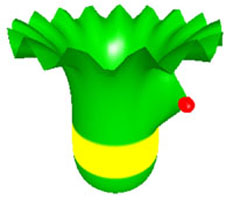 |
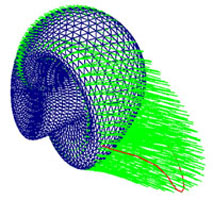 |